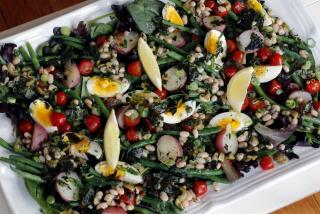Our American Diet Divides Us Into Classes of Workers and Bosses
- Share via
Diets are political. And the politics of the Atkins and Ornish diets has proved to be so divisive that Agriculture Secretary Dan Glickman, in an almost Hegelian scenario of the relation between the state and civil society, has suggested that government researchers should do an impartial study of the two, thereby putting an end to the civil strife.
Like everything else in social life, diets are determined not by what people desire but by the conditions of their class. This is quite an un-American thing to say, but people eat class and not food; food preferences are shaped by what one can afford to choose.
By class, we do not mean lifestyle, where one shops, what accent one has or what car one drives. These are signs of cultural prestige. They belong to social semiotics and not class. Class depends on people’s position in the social relations of production: Do they buy other people’s labor and make a profit from it? Or do they sell their own labor in order to live?
The antagonism between the Atkins and Ornish diets and the politics that has divided their followers are class politics appearing as personal tastes in food, health and bodily aesthetics.
The Atkins diet is a proletarian diet: meat, eggs and other high-protein sources along with usually forbidden fats, especially butter and cream. This is “real food,” according to Atkins, not upper-class “invented, fake food.” In his recent New Yorker piece “On Impact,” about recovering from a serious injury, Stephen King highlights the class culture of meat, writing that he and his wife “came from similar working-class backgrounds; we both ate meat.” Meat is the food of the working people; a food of necessity for the class that relies on the raw energy of its body for subsistence.
The Atkins diet is a worker’s diet that is highly satiating without requiring any special attention or calculation--unlike the elaborately complex Ornish plan, which is a full-time avocation in itself. All the Atkins’ dieter needs to do is avoid nearly all carbohydrates and eat only “pure proteins” and “pure fats.”
The Atkins diet books are written in a realistic style and shaped by what playwright Bertolt Brecht calls “coarse thinking”--thought that is highly suspicious of bourgeois indulgences and cultural elegance. When questioned about some of the inelegant consequences of his diet (such as bad breath from ketosis), cardiologist Robert Atkins laughs at the bourgeois mind-set that puts such refinements ahead of the strong, healthy body his audience needs to earn a living. He is contemptuous of the “sophisticated” bourgeois lifestyle that has made “low-fat, high-carbohydrate” diets dominant. This dominance, like the dominance of the bourgeoisie, is undeserved because, Atkins argues, this diet “hasn’t . . . done a thing to take pounds off.”
The low-fat, vegetarian Ornish diet, in contrast, is a diet for those with the time and leisure to play and experiment. It entails extensive lifestyle changes. Eating becomes a full-time leisure activity, requiring frequent “grazing” because with the low-fat, high-carbohydrate diet, according to internist Dean Ornish, “you get hungry sooner [and] feel full faster.” Eating becomes a gaze into one’s soul: a meditation, a Zen moment in which a single bite becomes “exquisitely satisfying.” It is an extended Proustian moment.
In its substance, the Ornish diet is elegant, colorful and highly pleasurable. The recipes, created by top gourmet chefs from places like Chez Panisse in Berkeley and Lutece in New York City, are instances of romancing food.
In Ornish’s “amazing graze” of constant nibbling, each bite becomes “heaven.” But all Atkins promises is an “amazing no-hunger weight loss.” One diet offers assurances of continual sensual pleasure, the other a pledge for the absence of hunger. The diets perform what Marx and Engels regarded as the feature of advanced capitalism: society “splitting up into two great classes.”
In spite of their innumerable surface variations, all diets repeat the two fundamental divisions of society into the classes of workers and owners. In eating food, we eat our class.


